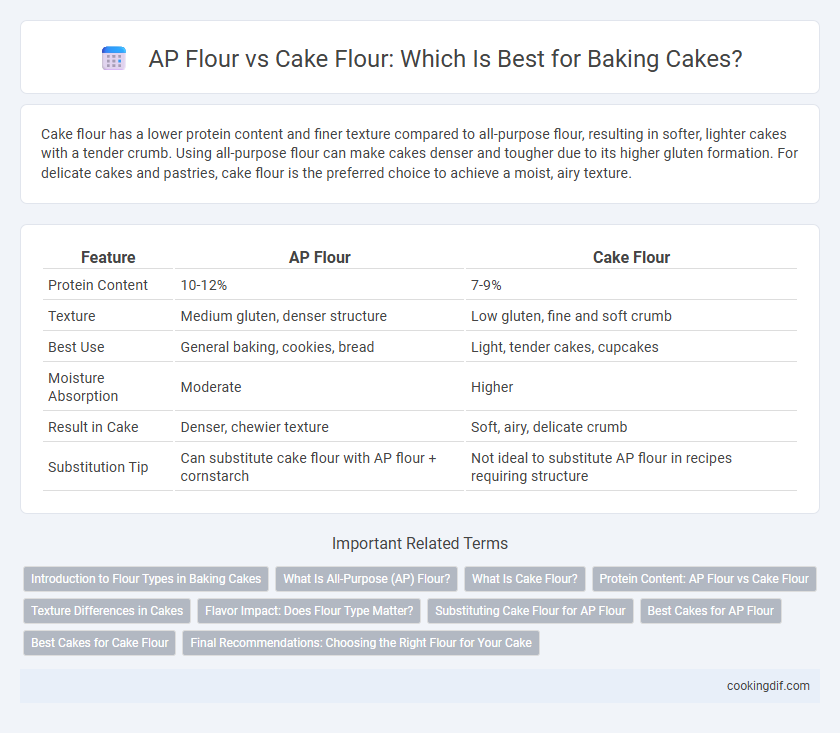Cake flour has a lower protein content and finer texture compared to all-purpose flour, resulting in softer, lighter cakes with a tender crumb. Using all-purpose flour can make cakes denser and tougher due to its higher gluten formation. For delicate cakes and pastries, cake flour is the preferred choice to achieve a moist, airy texture.
Table of Comparison
| Feature | AP Flour | Cake Flour |
|---|---|---|
| Protein Content | 10-12% | 7-9% |
| Texture | Medium gluten, denser structure | Low gluten, fine and soft crumb |
| Best Use | General baking, cookies, bread | Light, tender cakes, cupcakes |
| Moisture Absorption | Moderate | Higher |
| Result in Cake | Denser, chewier texture | Soft, airy, delicate crumb |
| Substitution Tip | Can substitute cake flour with AP flour + cornstarch | Not ideal to substitute AP flour in recipes requiring structure |
Introduction to Flour Types in Baking Cakes
AP flour, or all-purpose flour, contains a moderate protein content of about 10-12%, offering versatility for various baking needs but resulting in denser cakes. Cake flour has a lower protein content, around 7-9%, and is finely milled to produce delicate, tender crumb structures ideal for light and airy cakes. Choosing the right flour impacts the cake's texture, rise, and moisture retention, making cake flour the preferred choice for soft, fluffy cakes.
What Is All-Purpose (AP) Flour?
All-purpose (AP) flour is a versatile flour made from a blend of hard and soft wheat, providing a moderate protein content of about 10-12%, which makes it suitable for a wide range of baked goods. Unlike cake flour, which has lower protein (7-9%) for finer, tender crumb cakes, AP flour can result in denser cake textures due to higher gluten formation. Understanding the difference in protein levels helps bakers choose AP flour when aiming for structure and chewiness, while opting for cake flour when a delicate, soft cake is desired.
What Is Cake Flour?
Cake flour is a finely milled, low-protein flour typically containing 7-9% protein content, which creates a tender and delicate crumb in baked goods. Its soft texture and low gluten-forming potential make it ideal for cakes, producing a light, airy structure compared to all-purpose (AP) flour's higher protein content of 10-12%. Selecting cake flour over AP flour results in a finer crumb and more moist, tender cakes, essential for recipes requiring soft texture and subtle crumb structure.
Protein Content: AP Flour vs Cake Flour
All-purpose flour typically contains 10-12% protein, providing moderate gluten development suitable for a variety of baked goods. Cake flour, with a lower protein content of around 7-9%, produces a finer, softer crumb ideal for delicate cakes. Choosing cake flour over all-purpose flour results in lighter texture and tenderness due to reduced gluten formation.
Texture Differences in Cakes
AP flour contains higher protein content, resulting in more gluten development and a denser, chewier cake texture. Cake flour has lower protein and is finely milled, producing a softer, lighter, and more tender crumb in cakes. Choosing cake flour enhances delicate textures, while AP flour is better suited for sturdier baked goods.
Flavor Impact: Does Flour Type Matter?
Cake flour's lower protein content results in a finer, more tender crumb, enhancing the delicate flavor of cakes by allowing other ingredients to shine. All-purpose flour's higher protein contributes to a denser texture, which can slightly mute the subtle flavors in cakes. Choosing cake flour over all-purpose flour generally produces a lighter, more flavorful dessert with a soft, airy mouthfeel.
Substituting Cake Flour for AP Flour
Substituting cake flour for all-purpose (AP) flour results in a softer, lighter texture due to cake flour's lower protein content, which reduces gluten development. When replacing AP flour with cake flour, use 1 cup plus 2 tablespoons of cake flour for every cup of AP flour to maintain proper texture and structure. This adjustment ensures baked goods like cakes remain tender and moist while preserving their shape and rise.
Best Cakes for AP Flour
All-purpose (AP) flour offers versatility with a moderate protein content of around 10-12%, making it ideal for dense and moist cakes like pound cakes and carrot cakes. Its balanced gluten formation provides structure without sacrificing tenderness, ensuring consistent results across most cake recipes. For rich, sturdy cakes that hold their shape well, AP flour is often the preferred choice over cake flour.
Best Cakes for Cake Flour
Cake flour, with its lower protein content around 7-8%, produces the softest, most tender cakes by minimizing gluten formation. AP flour, containing 10-12% protein, delivers denser, chewier textures, making it less ideal for delicate sponge and chiffon cakes. For airy, moist cakes like angel food, genoise, and classic layer cakes, cake flour provides superior crumb and lightness.
Final Recommendations: Choosing the Right Flour for Your Cake
For a tender and delicate crumb, cake flour is the ideal choice due to its lower protein content and fine texture, which absorbs liquids well and produces softer cakes. All-purpose flour can be used as a substitute but may result in a denser, chewier texture because of its higher gluten formation. To achieve the best results, prioritize cake flour for light, airy desserts, while all-purpose flour suits heartier cakes where structure is more important.
AP Flour vs Cake Flour for flour choice Infographic

 cookingdif.com
cookingdif.com